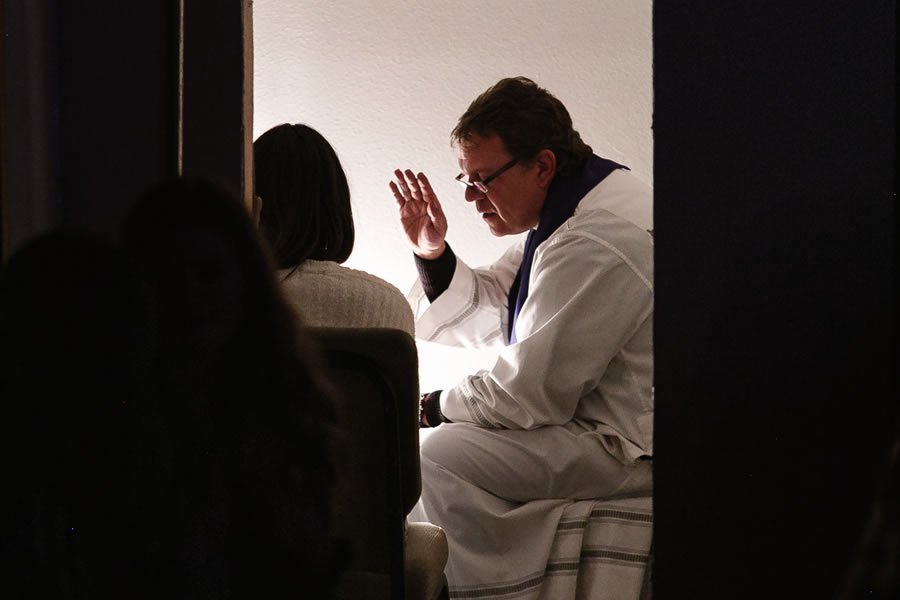
Revised Translation of the Order of Reconciliation
by Rev. Gabriel Baltes, O.S.B. | 04/23/2023 | A Message from Our PastorDear Parishioners, Pilgrims, Visitors, and Faith Seekers,
As many of you are aware, the English translation of the Order of Reconciliation, aka the Sacrament of Confession, has recently been revised by the Holy See. This revision came as a result of the Vatican’s desire to ensure that all liturgical translations are aligned, as closely as possible, with the official Latin text. This monumental effort to retranslate all our liturgical texts began with the Roman Missal in 2011 and has continued with all the other sacramental rites including Reconciliation.
Along with the re-translation of the texts that are a part of Reconciliation, there are several changes to the structure of the rite itself. The changes to both the texts and the structure are minimal. I doubt that most people would even notice the textual changes. One of the great benefits that resulted from this entire project has been the inclusion of more textual options for Penance Services, Scripture suggestions, and a total of 10 Acts of Contrition that penitents are welcome to pray. There is still the option for a penitent to spontaneously compose his/her Act of Contrition.
The following are the major changes in the order of the rite itself.
- When the penitent sits or kneels before the priest or behind the confessional screen, he/she is to be greeted “with kindness and friendly words.” The priest and penitent then make the sign of the cross with the traditional formula, In the name of the Father, and of the Son, and of the Holy Spirit. Amen.
- The priest then offers the penitent a word of encouragement to trust in God’s mercy such as May God who has shone his light in our hearts grant that you may truly know your sins and his mercy.
- There is the option for the priest to offer a brief reading from Scripture
- Penitents are not required to begin with Bless me Father for I have sinned. Nor are they required to mention when their last confession was celebrated. For pastoral reasons, the priest may ask this question.
- Penitents may begin their confession by reciting the Confiteor used at Mass, i.e., I confess to Almighty God and to you… or they may simply confess their sins. It is not necessary to mention how many times any of each of the sins was committed.
- After the confession of sins, the priest offers a suitable penance taking care to adapt to the penitent’s circumstances in every way. This is a very pastoral tone making the penance a much more personal and fitting effort to promote ongoing conversion in the life of the penitent.
- The priest then invites the penitents to express their contrition with 1 of 10 different prayers or one that is spoken from the penitent’s heart.
- This is followed by the Prayer of Absolution that has two subtle changes.
Instead of praying; God the Father of mercies, through the death and resurrection of his Son, has reconciled the world to himself and sent the Holy Spirit among us for the forgiveness of sins; through the ministry of the Church may God give you pardon and peace. And I absolve you from your sins, In the name of the Father, and of the Son and of the Holy Spirit. Amen
He now prays; God the Father of mercies, through the death and resurrection of his Son, has reconciled the world to himself and poured out the Holy Spirit among us for the forgiveness of sins; through the ministry of the Church may God grant you pardon and peace. And I absolve you from your sins, In the name of the Father, and of the Son and of the Holy Spirit. Amen.
The use of the phrase poured out, emphasizes the lavish abundance of God’s mercy, and the word grant expresses a more gratuitous action on the part of God. - Finally, the priest concludes by stating, Give thanks to the Lord for he is good. to which the penitent responds, For his mercy endures forever. The priest then dismisses the penitent with the words, The Lord has forgiven your sins. Go in peace.
As I noted previously, the changes in the revised rite are subtle but significant. No one should become anxious or nervous, however, about performing the rite in a scrupulously correct manner. It will take many years for these changes to become part of our confessional routine. In the meantime, we continue, as we always did, to rely on God’s tender mercy and his loving knowledge of each of us, his sons and daughters. This is the heart of the Sacrament of Reconciliation, and in this we rejoice.
BACK TO LIST BACK